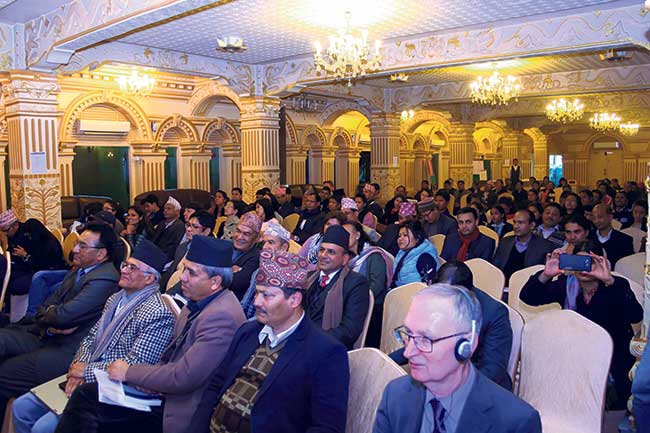KATHMANDU, Jan 24: A ‘Languages in Education’ symposium held by British Council Nepal on Tuesday discussed the use of English as a medium of instructions (EMI) for learning in classes of Nepal, and how effective they are.
The one-day symposium was held at Hotel Shanker, Lazimpat in collaboration with the Language Commission and was attended by teachers, students, administrators, policy makers as well as other stakeholders to discuss the status, progress and way forward for better teaching-learning process in classes.
In the first half of the session, Language Commission Chairperson Dr Lava D Awasthi gave his presentation on the Language Commission, including its current activities and future roadmap. It was followed by presentations from representatives of the British Council David Hayes, Vaishali Pradhan and Rhona Brown.
Awasthi also spoke about the possibility of conducting classes in a multi-lingual setting or in one’s mother language. But with more than 123 languages in Nepal and the growing adaptation of English language in the education system, concerns of English over-shadowing the existence of other languages were raised by the audience. To which Awasthi replied that language is ‘a way to embrace and celebrate diversity, and with correct education it is possible to erase the lines of inequality in terms of language and knowledge that we are facing’.
Teaching in English medium helps public schools thrive

Presenter David Hayes discussed why English language is being adopted as a medium of instruction. “The education system here is exam-oriented, while the command over English language is a base for judgment, so the inclination is natural. In a classroom where there is a small population of varied native speakers, it is not possible to teach in every language. In this scenario, English can be a progressive approach but it is only an addition to other language/skills.”
He further said, “Language is effective when it makes sense to the speakers (students) in their environment.” He also stressed on the need for database on Language of Instructions (LOI) used in classrooms and the need to develop teachers’ knowledge as well as parental literacy for children’s development.
Brown in her presentation explained that the use of English language as medium of instruction and to be good at English were two different things, and it should be kept that way. She promoted English as a subject (EaS) rather than compulsory English as a medium of instruction.
Meanwhile, Pradhan argued that the education system should stop responding to the parents’ demand of conducting classes strictly in English. Sharing research findings of National Initiative to Improve Teaching in English (NIITE), she also highlighted the need of a planned transition and practicalities of language switching (English-Nepali) as ways to conduct classrooms.
Further discussion was conducted on conducting classes in multi-lingual setting, but it could not form any constructive way to resolve the issue. When asked if conducting classes in one’s mother language would be possible and fruitful, Ramesh Lama, a Grade XI student of Shivapuri Seconday School and an attendee said, “Such approach will definitely promote development of one’s mother tongue. But in the present context, it is not possible. I know very little about my own culture and language, and if classes are to be conducted in my mother tongue it would be difficult for me to cope.”
A four-member panel of experts then discussed on education policies and practices in Nepal, Pakistan and other South Asian countries. They concluded that a day was not enough to come to a conclusion as to which medium of instruction was suited in Nepali classrooms. They suggested continuous evidence-based discussion on the topic and contribution from parents, teachers and students as well as government bodies and stakeholders to solve the issue.
On the sidelines of the event, seven different language stalls for Rai, Magar, Tharu, Tamang, Gurung, Maithali and Nepali Bhasa were also set up.



































